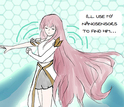News Release 17-050
NSF announces 2017 winners for Generation Nano: Small Science, Superheroes
Competition inspires high school students to learn the science behind nanotechnology

The winning comics illustrate the importance of creatively applying science to solve problems.
June 6, 2017
This material is available primarily for archival purposes. Telephone numbers or other contact information may be out of date; please see current contact information at media contacts.
Today, the National Science Foundation (NSF), in partnership with the National Nanotechnology Initiative (NNI), named the first- and second-place winners, as well as the People's Choice winner, for the second annual Generation Nano competition.
Generation Nano challenges high school students to imagine novel superheroes who use the power of nanotechnology -- technology on the scale of a nanometer, or 1 billionth of a meter -- to solve crimes or tackle a societal challenge. Students then tell their hero's story in a comic and video. Students learn about the science behind nanotechnology before applying nanotechnology-enabled tools and concepts to futuristic characters, said Mihail C. Roco, NSF senior advisor for science and engineering and a key architect of the National Nanotechnology Initiative (NNI).
"This competition is like a real-life exercise in modern society, where creativity and rigor combine to engineer novel products, smart infrastructure, life-saving medical treatments and more," Roco said. "Students use their imaginations to join emerging uses of nanotechnology with other fields, bringing new viewpoints and collective interest to scientific progress. The younger generation needs such skills, as they will live and work in a more advanced society than their teachers, and we wish success to all of them as they help create the future of nanotechnology."
The winners
- First Place
Hannah Kim and Daniel Kim from Thomas Jefferson High School for Science and Technology in Virginia for "Dilatant: Being bulletproof has never taken such a small effort." - Second Place
Symone Crowder from Northside High School in Georgia for "Mia Kei: Versatility is my specialty." - People's Choice
Ramona Park from Santa Fe High School in New Mexico for "Agent X: 'X' marks the spot."
"I was so impressed by the imaginative ways that students used nanotechnology to ease human suffering, cure disease, fight criminals and clean up the environment in this year's Generation Nano contest," said Lisa Friedersdorf, director of the National Nanotechnology Coordination Office. "The winning comics showcase the importance of creatively applying science to solve problems. I am sure these comics and videos will excite other students and inspire them to think about how they can use nanotechnology to improve the world."
Students' superhero creations had to address one of four missions using their nanotechnology powers:
- Justice: Defending the defenseless against criminals, bullies, supervillains and others who wish to do harm.
- Relief: Providing aid to victims of disasters, famine, drought and other situations where people are in need.
- Health: Striving to heal the sick and injured.
- Environment: Focusing on clean energy, pollution control and a sustainable future.
Generation Nano participants were required to submit a short, written entry about their superheroes, a two- to three-page comic and a 90-second video. A panel of judges with expertise in either nanotechnology or comics evaluated each entry and selected semifinalists and finalists. The public selected the People's Choice winner from the list of finalists.
The judges
- Paul Weiss, presidential chair and distinguished professor of chemistry and biochemistry and of materials science and engineering at University of California, Los Angeles.
- Kevin Walsh, associate dean of research for the University of Louisville Speed School of Engineering.
- Annie Wu, an American illustrator best known for her work in "Black Canary" for DC Comics and "Hawkeye" for Marvel.
- Marjorie Liu, attorney and New York Times best-selling author of 17 novels, who recently wrote the comic book "Monstress."
The winners will be at the NSF booth at Awesome Con in Washington, D.C. June 16-18, and will also visit Capitol Hill. In addition, each winner is invited to tour the nearest NNI center.
Visit the Generation Nano website for competition details, such as eligibility criteria, entry guidelines, timeline, prizes, and videos and comics from the winners and finalists.
-NSF-
-
Students had to address one of four missions.
Credit and Larger Version -
Judges with expertise in either nanotechnology or comics selected semifinalists and finalists.
Credit and Larger Version
Media Contacts
Sarah Bates, NSF, (703) 292-7738, email: sabates@nsf.gov
The U.S. National Science Foundation propels the nation forward by advancing fundamental research in all fields of science and engineering. NSF supports research and people by providing facilities, instruments and funding to support their ingenuity and sustain the U.S. as a global leader in research and innovation. With a fiscal year 2023 budget of $9.5 billion, NSF funds reach all 50 states through grants to nearly 2,000 colleges, universities and institutions. Each year, NSF receives more than 40,000 competitive proposals and makes about 11,000 new awards. Those awards include support for cooperative research with industry, Arctic and Antarctic research and operations, and U.S. participation in international scientific efforts.
Connect with us online
NSF website: nsf.gov
NSF News: nsf.gov/news
For News Media: nsf.gov/news/newsroom
Statistics: nsf.gov/statistics/
Awards database: nsf.gov/awardsearch/
Follow us on social
Twitter: twitter.com/NSF
Facebook: facebook.com/US.NSF
Instagram: instagram.com/nsfgov




